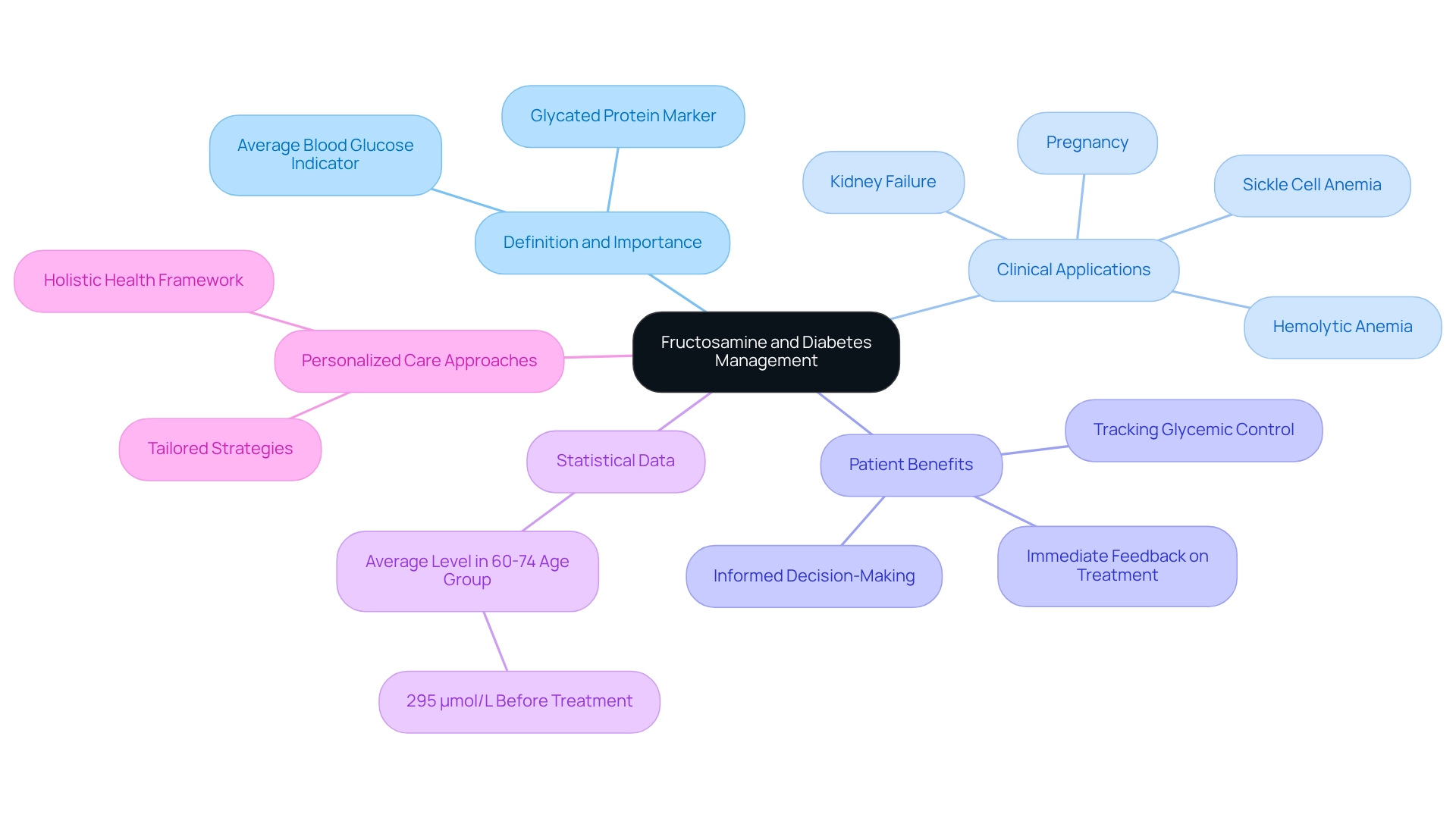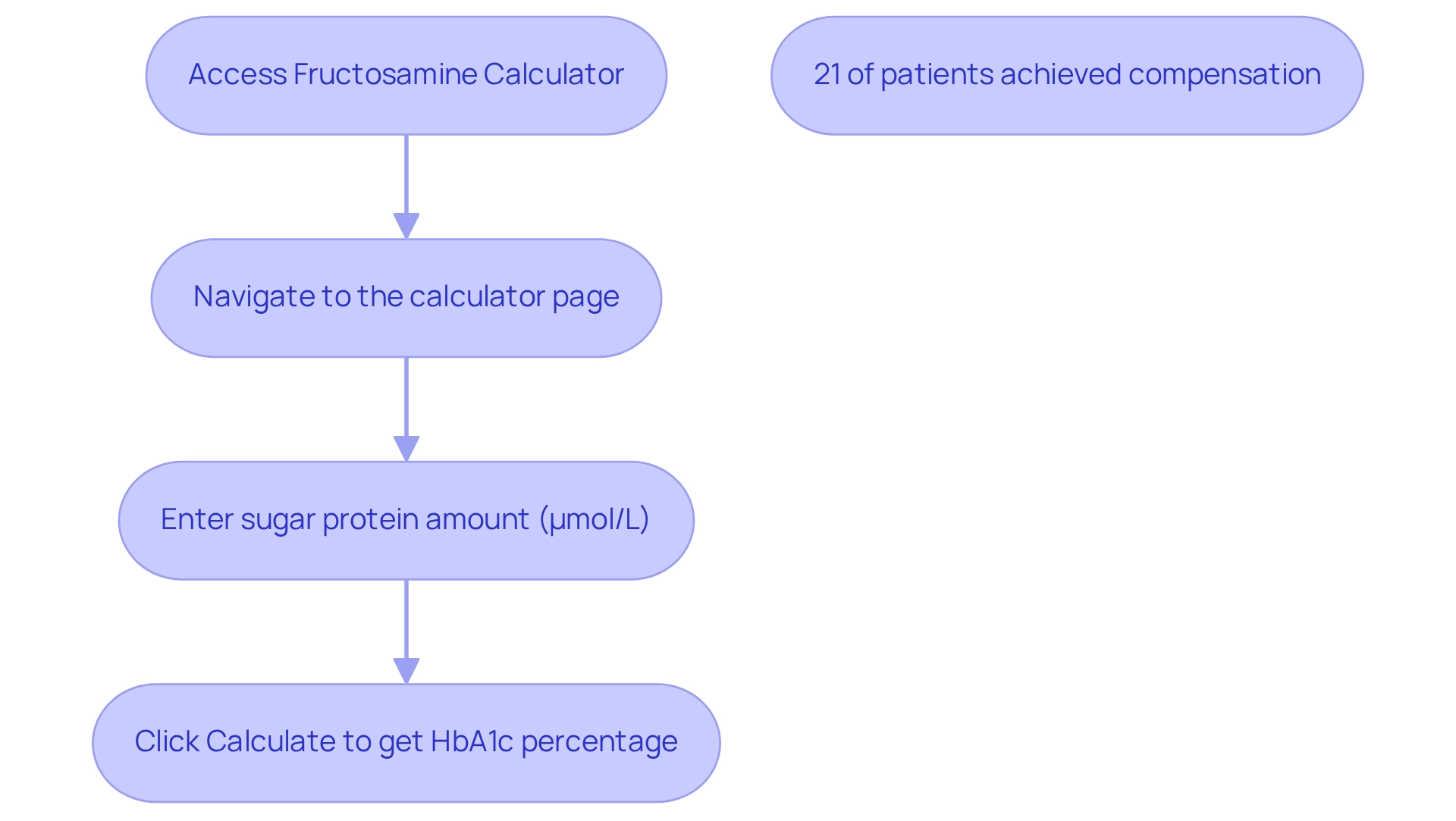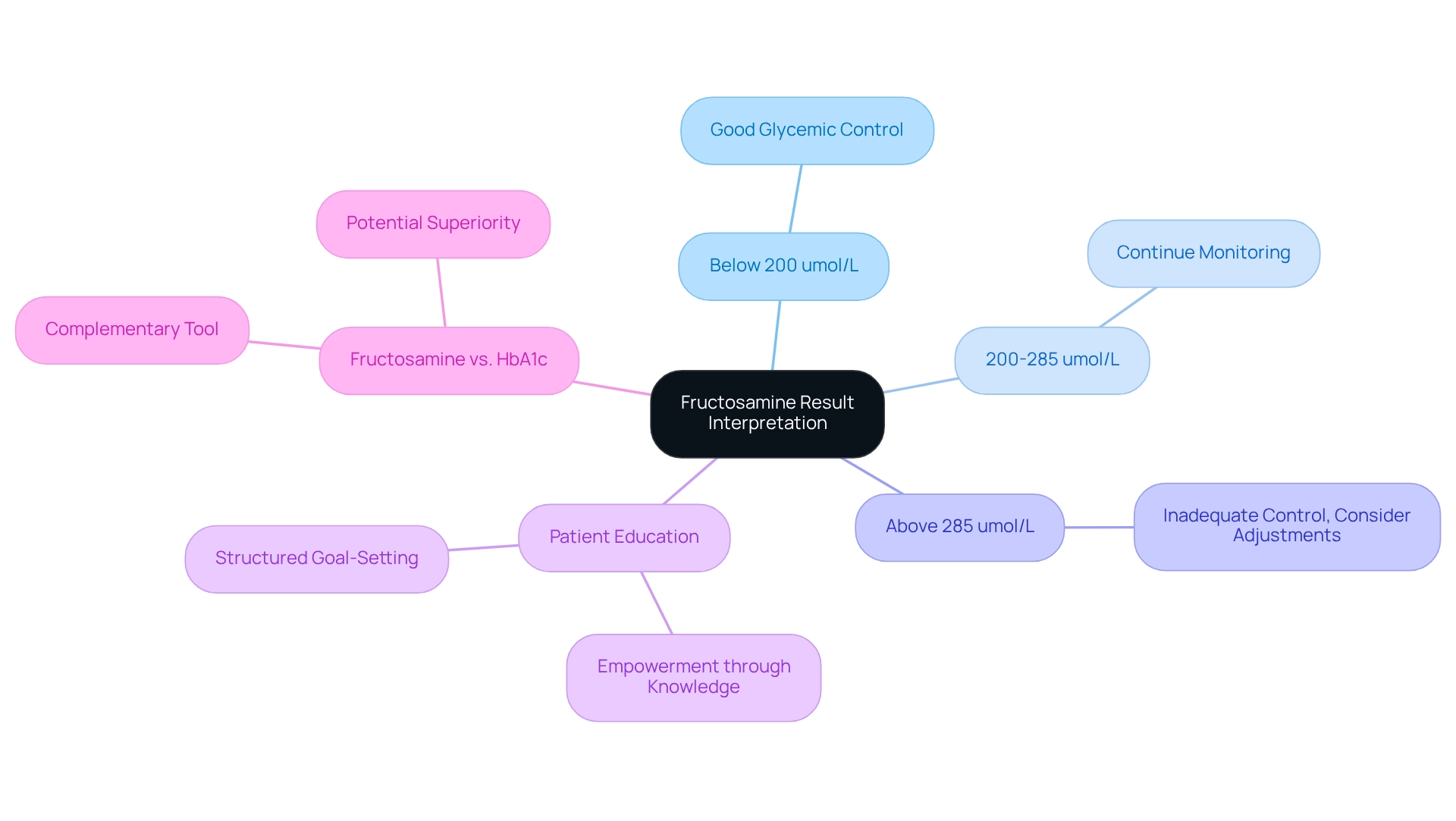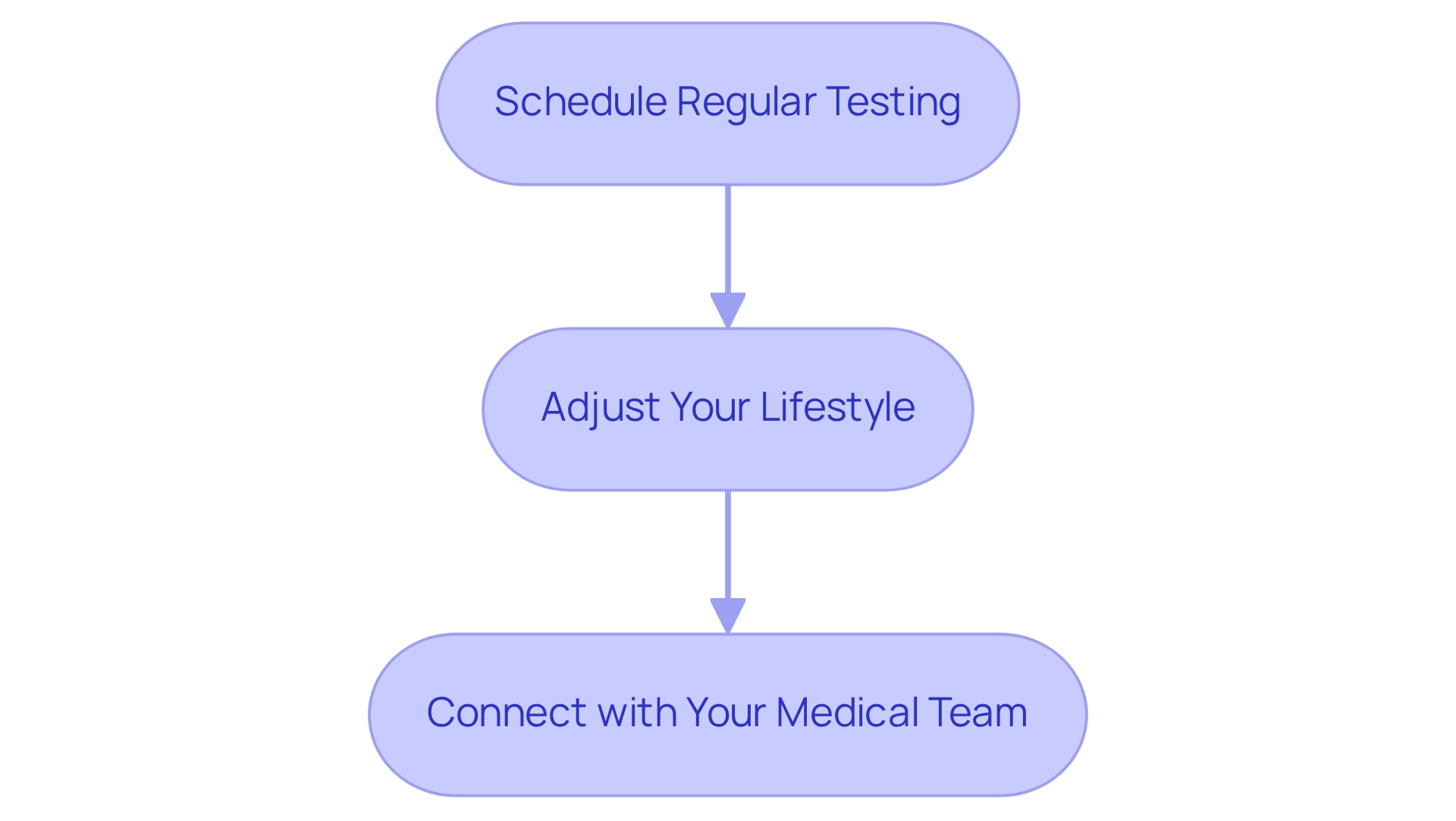Overview
This article highlights how mastering the fructosamine calculator can significantly improve diabetes management. By providing a more accurate assessment of average blood glucose levels over the past 2 to 3 weeks, it offers a pathway to better health. Many patients find that the fructosamine test is especially beneficial for those with conditions that impact HbA1c accuracy. This insight allows for personalized treatment adjustments and fosters better glycemic control through regular monitoring and thoughtful lifestyle changes.
It’s important to recognize that managing diabetes can be challenging. However, with tools like the fructosamine calculator, individuals can take control of their health. By understanding their glucose levels more accurately, they can make informed decisions that lead to improved well-being. Regular monitoring and lifestyle changes can feel overwhelming, but each step taken is a step toward better health. Remember, you are not alone on this journey; support is available, and positive changes are within reach.
Introduction
In the journey of managing diabetes, it’s essential to recognize the challenges many face with blood glucose monitoring. Understanding these nuances can truly make a difference in achieving optimal health outcomes. One tool that stands out is fructosamine testing, which offers valuable insights into average glucose levels over the past few weeks. This test can be particularly helpful for individuals who struggle with traditional HbA1c measurements, including those with hemoglobinopathies or fluctuating glucose levels.
Many patients find that by exploring the mechanics of fructosamine, they can tailor their management strategies more effectively. This empowers them to make informed decisions that resonate with their unique health profiles. As the landscape of diabetes care continues to evolve, it’s important to recognize the significance of fructosamine testing. This awareness can inspire individuals to take proactive steps toward better health, supported by personalized interventions and community resources.
Have you ever felt overwhelmed by the options available for managing your diabetes? You’re not alone. Many share this experience, and understanding the right tools can help ease that burden. Together, let’s explore how fructosamine testing can be a part of your path to a healthier life.
Understand Fructosamine and Its Role in Diabetes Management
Fructosamine, a glycated protein, can be assessed using a fructosamine calculator. This tool serves as a useful marker of average blood glucose concentrations over the prior 2 to 3 weeks. Many patients find this test particularly beneficial for tracking glycemic control in situations where it provides more accurate outcomes than HbA1c—such as in individuals with hemoglobinopathies or those experiencing rapid changes in glucose concentrations. It’s important to recognize that understanding the mechanics of this specific blood sugar marker empowers patients to make informed choices about their glucose care. This aligns perfectly with a personalized functional medicine approach that emphasizes tailored strategies for each individual’s unique health profile.
The assessment plays a crucial role in identifying trends in blood glucose control, enabling timely adjustments to treatment plans. For example, persistently high concentrations of certain compounds may indicate the need for adjustments in medication or lifestyle changes to improve glycemic control. This flexibility is essential within a holistic health framework, where thorough evaluations and tailored interventions are key to effectively managing blood sugar.
Significantly, the average concentration in individuals aged 60 to 74 years was determined to be 295 µmol/L prior to treatment. This information can assist healthcare providers in customizing interventions that enhance patient outcomes.
Additionally, this assessment proves beneficial in numerous clinical situations, including during pregnancy and for individuals with disorders such as hemolytic anemia, sickle cell anemia, and kidney failure. In these cases, A1C results may not accurately represent glycemic status. This highlights the significance of individualized functional medicine strategies for managing blood sugar care. Case studies illustrate the test’s effectiveness in controlling blood sugar levels more efficiently after adjustments in medication or insulin.
As the field of blood sugar care progresses, the importance of specific monitoring tools in tracking glucose levels is increasingly recognized. Expert opinions underscore its significance, particularly in providing immediate feedback on treatment effectiveness, which is crucial for optimizing patient outcomes. By integrating specific testing into their care routine, individuals can take proactive measures toward better health and an enhanced quality of life, supported by lifestyle changes and community resources available in San Marcos, CA.
Our clinic is committed to state-of-the-art testing, ensuring that each patient receives the most accurate and personalized care possible. Remember, you are not alone on this journey; we are here to support you every step of the way.
Access the Fructosamine Calculator
Using a blood sugar calculator can be a straightforward process, and it’s a great step toward managing your health. You can easily access reliable calculators through trusted health websites or dedicated mobile apps designed for glucose control. One particularly valuable resource is the fructosamine calculator, available on various health platforms for A1C conversion. To make the most of this tool, consider these simple steps:
- Navigate to the calculator page.
- Enter your sugar protein amount in micromoles per liter (µmol/L).
- Click ‘Calculate’ to receive your estimated HbA1c percentage.
This conversion is essential as it sheds light on your glucose control over time, empowering you to have informed discussions with your healthcare provider. Research indicates that certain sugar concentrations are closely linked to HbA1c values, making the fructosamine calculator a helpful resource in managing your blood sugar. In fact, studies have shown that the minimum concentration before treatment is typically around 211.5 µmol/L, underscoring the importance of monitoring these values for effective blood sugar management.
Moreover, a study focusing on inpatient treatment outcomes revealed that 21% of patients achieved compensation, highlighting the positive impact of effective health control strategies.
To enhance your blood sugar management journey, consider setting SMART goals—specific, measurable, attainable, relevant, and time-bound—related to your amino sugar readings. For example, you might aim to reduce your sugar protein concentration by a certain percentage within a set timeframe. By utilizing these calculators and tracking your progress, you can gain a clearer understanding of your condition and take proactive steps toward better health outcomes.
As Sahana R Naik notes, “The concentrations of this compound are significantly linked to HbA1c values, so it can serve as a biomarker to evaluate glycaemic control in individuals with type 2 diabetes, particularly when HbA1c is considerably inaccurate or missing.” However, it’s important to recognize that further investigation is needed to confirm the relationship between specific substances and glucose concentrations. Remember, you’re not alone in this journey, and each step you take brings you closer to better health.
Interpret Your Fructosamine Results
Understanding your test results is crucial for managing your blood sugar effectively. Typical concentrations of the substance generally range from 200 to 285 umol/L. Let’s explore how to interpret your results:
- Below 200 umol/L: This range signifies good glycemic control, indicating that your diabetes management strategies are working well.
- 200-285 umol/L: Levels in this range are generally acceptable, but it’s wise to continue monitoring to ensure ongoing control.
- Above 285 umol/L: Elevated concentrations suggest inadequate glycemic control. It may be helpful to discuss potential adjustments to your treatment plan with your healthcare provider.
It’s important to recognize that trends over time hold more significance than a single measurement. Many patients find that consistently monitoring their sugar indicators through tools like fitness apps, journals, or pedometers can provide valuable insights into their overall glycemic regulation and guide their diabetes management plans. By incorporating structured goal-setting—such as establishing specific objectives for your blood sugar measurements—you can enhance your focus and motivation in managing your health.
Research shows that persistence in goal-setting can positively impact performance. For example, scores improved from 3.4 (SD = 2.0) to 3.8 (SD = 1.9) in specific conditions, highlighting the effectiveness of structured goal-setting.
As noted by Luis Jesuino de Oliveira Andrade, “This compound has not been utilized as frequently as HbA1c for tracking metabolic control in DM, although several studies suggest that it may be superior to HbA1c in this context.” This underscores the importance of considering specific protein levels alongside conventional metrics like HbA1c.
Dr. Shumard emphasizes the value of patient education in interpreting these results. Many patients have expressed gratitude for the knowledge gained through his resources, empowering them to take proactive steps in managing their health. By focusing on goal-setting and regular progress monitoring, you can cultivate a sense of accomplishment and maintain engagement in your health care. The fructosamine calculator is increasingly recognized as a complementary tool to HbA1c, offering a more comprehensive view of glycemic control and assisting in tailoring treatment strategies effectively.
Incorporate Fructosamine Monitoring into Your Daily Routine
Integrating a fructosamine calculator into your daily routine can significantly enhance your blood sugar management. Have you considered how this tool could support you? Here are some essential steps to help you along the way:
- Schedule Regular Testing: Collaborate with your healthcare provider to establish a testing timetable for your sugar levels, typically recommended every 1 to 3 months.
Regular testing is vital for tracking your glycemic control over time. It’s important to recognize that research indicates only a small percentage of diabetes patients engage in routine testing, highlighting the need for greater awareness and compliance. Keeping track of your results is crucial: maintain a detailed record of your fructosamine values alongside your daily blood glucose readings and HbA1c results.
This practice not only helps identify trends but also informs your treatment decisions, allowing for timely adjustments to your management plan. Many patients find that consistently assessing their progress encourages responsibility and permits the adjustment of goals in response to changing health conditions, which is essential for successful diabetes management.
- Adjust Your Lifestyle: Let your test results guide your dietary choices, exercise, and medication adherence.
For instance, elevated levels of certain blood markers may indicate the need to reduce carbohydrate intake or increase physical activity for better overall glycemic control. Real-life adjustments could involve swapping high-carb snacks for healthier options or incorporating more physical activity into your daily routine. Engaging in outdoor activities, such as walking in nearby parks, can also enhance your physical fitness while effectively managing blood sugar levels.
- Connect with Your Medical Team: Share your test results during consultations to discuss potential modifications to your blood sugar management plan. Dr. Jason Shumard suggests that centers without prior experience using this test consider integrating a fructosamine calculator into their screening programs for hyperglycemia, especially for patients with fasting glucose levels above 100 mg/dL. This collaborative approach fosters improved health outcomes and empowers you to take an active role in your care.
While regular testing of blood sugar markers is crucial for individuals with high blood sugar levels, offering insights into average glucose levels over the past two to three weeks, it’s essential to acknowledge the limitations of current studies regarding these thresholds for predicting complications. By incorporating these practices into your routine, you can deepen your understanding of your condition and make informed choices that lead to better health. Additionally, exploring case studies on integrating fructosamine monitoring into diabetes routines can provide further context and support for these recommendations.
Conclusion
By recognizing the pivotal role of fructosamine testing in diabetes management, individuals can take significant strides toward achieving better health outcomes. This testing method serves as a valuable tool, particularly for those who may not respond well to traditional HbA1c measurements due to various health conditions. It’s important to understand that recognizing fructosamine levels allows patients to tailor their diabetes strategies, making informed decisions that align with their unique health profiles and needs.
Regular monitoring of fructosamine levels not only aids in identifying trends in glycemic control but also empowers patients to communicate effectively with their healthcare providers. Many patients find that this proactive approach can lead to timely adjustments in treatment plans, which are essential for maintaining optimal blood glucose levels. As the landscape of diabetes care continues to evolve, integrating fructosamine testing into routine management practices emerges as a crucial component of personalized healthcare.
Ultimately, embracing fructosamine testing can enhance the overall quality of life for individuals living with diabetes. By taking charge of their health through structured goal-setting, consistent monitoring, and lifestyle adjustments, patients can cultivate a more engaged and effective approach to managing their condition. The journey toward better health is supported not only by individual efforts but also by community resources and healthcare expertise, reinforcing the importance of a comprehensive strategy in diabetes management.
Frequently Asked Questions
What is fructosamine and how is it assessed?
Fructosamine is a glycated protein that can be assessed using a fructosamine calculator. This tool provides a marker of average blood glucose concentrations over the prior 2 to 3 weeks.
Why might patients find the fructosamine test beneficial?
Patients may find the fructosamine test particularly beneficial for tracking glycemic control in situations where it offers more accurate outcomes than HbA1c, such as in individuals with hemoglobinopathies or those experiencing rapid changes in glucose concentrations.
How does understanding fructosamine empower patients?
Understanding the mechanics of fructosamine allows patients to make informed choices about their glucose care, aligning with a personalized functional medicine approach that emphasizes tailored strategies for each individual’s health profile.
What role does fructosamine assessment play in treatment adjustments?
The assessment helps identify trends in blood glucose control, enabling timely adjustments to treatment plans. Persistently high concentrations may indicate the need for changes in medication or lifestyle to improve glycemic control.
What is the average fructosamine concentration in individuals aged 60 to 74 years?
The average concentration in individuals aged 60 to 74 years was determined to be 295 µmol/L prior to treatment, assisting healthcare providers in customizing interventions to enhance patient outcomes.
In what clinical situations is the fructosamine assessment particularly useful?
The fructosamine assessment is beneficial during pregnancy and for individuals with disorders such as hemolytic anemia, sickle cell anemia, and kidney failure, where A1C results may not accurately represent glycemic status.
How does the fructosamine test contribute to blood sugar management?
Case studies show that the fructosamine test can help control blood sugar levels more efficiently after adjustments in medication or insulin, highlighting its effectiveness in managing blood sugar care.
What is the significance of monitoring tools like fructosamine in blood sugar care?
Monitoring tools like fructosamine are increasingly recognized for their importance in tracking glucose levels and providing immediate feedback on treatment effectiveness, which is crucial for optimizing patient outcomes.
How does the clinic support patients in their health journey?
The clinic is committed to state-of-the-art testing, ensuring that each patient receives accurate and personalized care, and emphasizes that patients are not alone on their journey, offering support every step of the way.



